Chris Allsop attends the Sound of the Dolomites festival for world-class music in a breath-taking natural setting, and then discovers the unspoiled gem known as ‘Little Venice’…
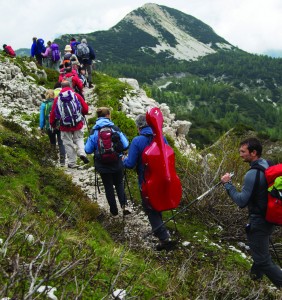
The hills are alive with the sound of music. Except this is northeast Italy, not Austria, and it might be a tad rude – if not inaccurate – to label the soaring Dolomites as ‘hills’. But there is certainly music, and at high elevation, which is all part of the annual Sound of the Dolomites festival.
Taking place each year over July and August, the Sound of the Dolomites is a series of open-air concerts (classical, jazz, and world music) set amid the grassy amphitheatres and limestone sound stages of Trentino’s mountainous north. Central to the festival’s success is the participation of Mario Brunello, a world-class Italian cellist who revels in the “purity” of music-making among the lofty peaks.
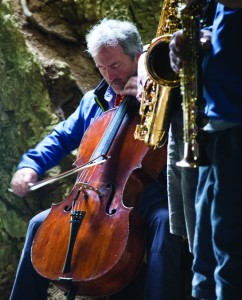
As Brunello gets closer to nature, the festival allows the public to get closer to Brunello. For €355 (most festival events are free) attendees can hike through alpine splendour alongside the maestro – who totes his antique Maggini cello in a Ferrari-designed, carbon fibre hiking case. During the trek you pause for impromptu concerts on airy summits or as a pre-dinner treat in cosy mountain inns, before the journey culminates in a final, spectacular outdoor concert.
Which is why I had to dust off my rucksack, unnecessarily overload it with wet weather gear after misreading the forecast, and join Brunello for this year’s musical/mountain foray.
The White War
To mark the centenary of the Great War, Brunello was joined this year by the Signum Saxophone Quartet. Comprising a Slovenian, a Croatian and two German musicians, this melodious multi-national blend was designated the ‘Peace Orchestra’. Furthermore, our path was to traverse a section of the Eastern Front – in these picturesque Alpine heights, Italians had doggedly fought the Austro-Hungarian army at altitudes frequently exceeding 2,000 metres and in often sub-zero conditions – a three-year attritional engagement called la Guerra Bianca, or White War. As we walked, I chatted with members of our 58-strong group. Sergio from Genoa – a die-hard, middle-aged Sound of the Dolomites lifer – has made a number of close friends from all over the country through his 20 years of loyal festival going. Others asked for an explanation of my overstuffed rucksack.
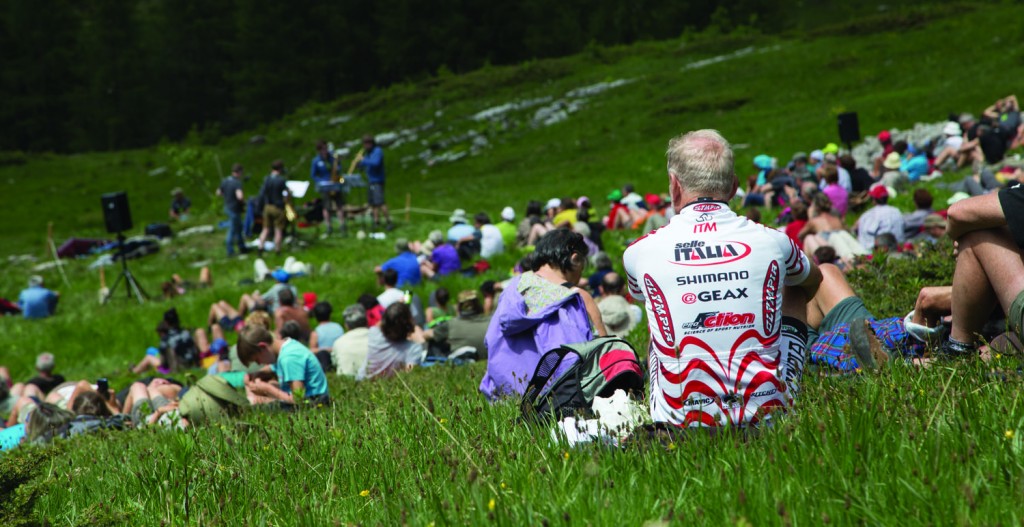
“When Mario is with us,” local Maddalena responded, “it does not rain.” Maddalena’s female friends laughed, and I began to understand why silver fox Brunello’s wife was also on the hike…
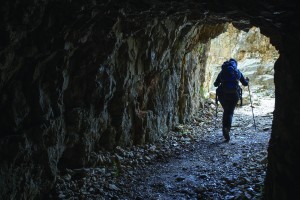
Our first impromptu classical concert took place in a ragged roofed cave (beat that, Beatles) with surprisingly good acoustics – one of 52 tunnels carved into the Monte Pasubio mountainside by the Italian army in 1916. The tunnels, known as the ‘Road of the First Army Corps’, are one feature of the wider Parco della Memoria or Great War Memorial Park of Trentino, the umbrella term covering the region’s visible wartime legacy.
Trails crisscross the park, including the 500km Peace Path that hugs the former front line. Along its route you’ll encounter abandoned artillery, gravity-defying forts clinging to rock walls, as well as used cartridges and fragments from soldiers’ boots scattered amid the tiny amethyst, yellow, and powder blue flowers that border the trails.
Over the first two days, we enjoyed three more impromptu concerts – one in a bomb-carved crater; one in a rifugio (traditional Alpine lodge) dining room; and another packed into a tiny church. The rifugios (the first, Achille Papa, named after a WW1 general) were wood-panelled and snug, serving up flasks of wine, pizza antipasti, and hearty mains of venison sausage, tangy sauerkraut, and polenta that reminded you of your arrival at a cultural intersection of Europe.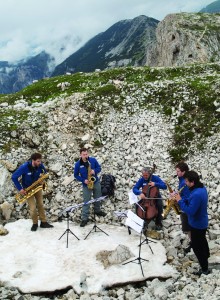
From Achille Papa, bristling peaks smoothed away into lush green foothills that marked the border with neighbouring Veneto province. We tramped down from the heights into soft Alpine meadows thick with dwarf pine (prized for homemade schnapps and sore throat remedies), vivid blue trumpet gentians, and drifts of rosemary.
The final gig was on the afternoon of the third day. Despite it being a Thursday, a 1,000-strong audience of hikers and cyclists began to gather in the garden of Rifugio Vincenzo Lancia and its surrounding countryside. Beers were swigged in the sunshine and friends greeted one another while the musicians set up.
Brunello and Signum treated us to a set list of pieces written between 1914 and 1918 by artists such as Stravinsky and Haydn, before concluding with a sombrely beautiful composition by George Butterworth, a promising English composer who was killed in action at the Somme. According to Maddalena’s friend, Isabella, there wasn’t a dry eye among her party by the concert’s close.
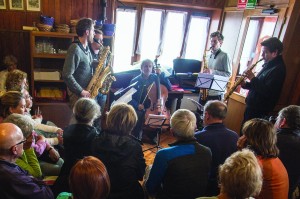
Exploring Rovereto
At the end of the concert we hiked to our minibus for the return journey to Rovereto, Trentino’s unspoiled second city. Often overlooked in favour of larger, more northerly Trento (recently voted Italy’s ‘Best City for Quality of Life’ by Italian daily Il Sole 24 Ore) this works in Rovereto’s favour, by thinning out the numbers of tourists and maintaining the city’s attractive insouciance.
Lying in a terraced valley and surrounded by peaks, Rovereto is a picturesque one-hour drive up the vine-carpeted Lagarina Valley from Verona airport. You can’t miss the striking Castello di Avio, sliding down the valley walls like a Dali clock (less distinct, but no less evocative is a rocky hillside on your right as you approach the city: Dante designated this an entrance to hell in his Inferno).
A city of art, war, and cycling, Rovereto’s residents zip around the streets on road bikes, and you can join them by hiring a bicycle from the e.motion stands dotted around town. Find one by the Museum of Modern and Contemporary Art of Trento and Rovereto, known more succinctly as the MART, and one of the city’s major tourism draws (the MART has recently been joined by Trento’s MUSE: a science museum designed by Renzo Piano).
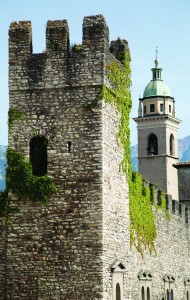
Opened in 2002, the MART houses a collection of international stature, but do look out too for works by the futurist artist Fortunato Depero, a local whose caryatid sculpture can be seen gilding a hat shop façade in the beautifully preserved Old Town.
An embedded history
In fact, as you stroll around the compact Old Town, you come across numerous hints – like Depero’s sculpture, for example – of Rovereto’s historical and cultural legacy. Daubs of tell-tale Venetian chequer swell up on alley walls like refined street art, ready reminders that the city used to be a part of the Venetian Empire – the Old Town is often referred to as ‘Little Venice’ for its architectural echoes of La Serenissima. Shells embedded in walls commemorate the city’s war-torn past: during WW1, the front line once split Rovereto right down the middle.
You can learn about the history (provided you can read Italian) at the 14th century Castello di Rovereto that looms above the Old Town, now the exhibition space for the superb and exhaustive Italian War History Museum.
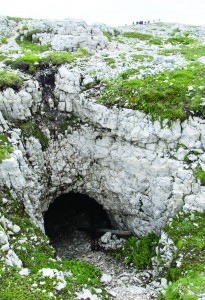
A marble plaque found in Via Mercerie commemorates the site where Mozart performed his first ever concert in Italy, in 1769 – apparently, Rovereto was a favourite with the Mozarts, as was the regional red wine, Marzemino. Procure a bottle next door from the eclectic Drogheri Giuseppe Micheli, while the deli opposite is the perfect spot to taste test the local Grana Trentino hard cheese. For coffee, find Piazza Cesare Battisti with its distinctive Neptune fountain and where the café, like most in the Old Town, seems perfectly positioned to glory in the warm afternoon light. Your velvety macchiato will be made with Bontadi beans: headquartered in Rovereto, this is Italy’s oldest coffee brand, its rich, roasting aromas a fixture in the backstreets since 1790.
But, ultimately, you can’t escape the legacy of war in Rovereto… or the music. Perched on a hillside above the city is the gargantuan Bell of the Fallen, a tolling bell memorial fashioned from melted down Great War artillery. Its regular, sonorous tones echo off the valley walls as dusk descends, its peals a plea to hit the bars, order a Negroni, and make some new friends.
To plan your trip to the next Sound of the Dolomites festival click here.
